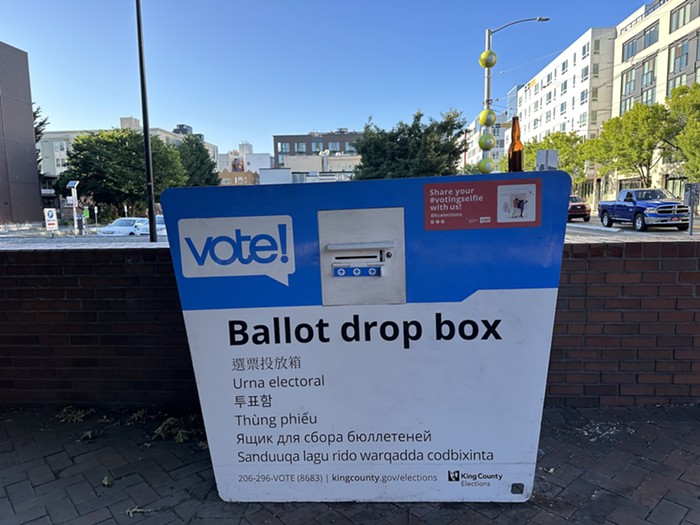The city has long restricted the sort of tenants that can lease space in Magnuson Park: concession stands, recreation-equipment rentals, a few nonprofits, and art studios. Certainly no commercial offices were allowed—a park rule prohibited them. But in the last year, the city has used fancy footwork to eliminate that restriction for Building 11, on Magnuson's north shore, and 20-odd artists are being evicted to make room for commercial development.
Under the plan, more than one-third of the 1940s building in Magnuson Park—one of several warehouses and hangars among the lawns and ballfields—would be renovated for commercial office space, rentable to any tenant, regardless of its contribution to the community.
"I think we're drifting away from our original vision of what Magnuson Park was supposed to be," says city council member Nick Licata, who in 1999 brokered the official deal transferring the naval property at Sand Point to the City of Seattle. (The U.S. Navy–owned land had been used as a park since the 1970s.) The city envisioned a park dedicated to the arts, recreation, and environmental stewardship. Now, Licata—along with the council's Parks & Seattle Center Committee chair Sally Bagshaw and Council Member Tom Rasmussen—is concerned with the changes under way.
It wasn't until August 2009 that Seattle Parks and Recreation skirted around land-use covenants put in place to keep the parcels from being leased to just anybody. "This property shall be used and maintained for public park and recreation purposes in perpetuity," the covenants on Magnuson Park state. Adding, "The property shall not be sold, leased, assigned or otherwise disposed of except to another eligible governmental agency."
Last year, the parks department (with the city council's blessing) persuaded the federal government to let the city transfer the covenant from Building 11 to property next to the former Crown Hill Elementary in Ballard. The parks department didn't make any announcements or field input regarding the covenants, and it is currently undergoing the same process for Building 2. The spaces would be divided into offices, a restaurant, and other commercial ventures.
Although public-private partnerships are a mechanism for preserving the park's pre-WWII buildings, several local park advocates are concerned about the commercialization of the park. Friends of Magnuson Park president Lynn Ferguson laments, "There's nothing in the leases that guarantees public access and public use, or at least gives priority to public and community use, just single commercial uses." She argues the community has been cut out of the deal because nonprofits, small businesses, and artists won't be able to afford market rents. The commercial spaces will run $20 to $30 a square foot on an annual basis, according to comparative listings in the area.
But parks department spokeswoman Dewey Potter defends the decision, while acknowledging that transferring covenants from a park to a former school ground was unusual. "It was necessary to make the partnerships pencil out [for the developers]," she says. (The developers include Darrell Vange, who unsuccessfully worked to build a Target next to Little Saigon over the past several years, sparking community outrage.) Most of the park's buildings are vacant and need $50 million to $75 million in total renovations, Potter says, and leasing to commercial developers will cover renovation costs. But many of the artists, who were leasing space month-to-month, are feeling betrayed.
"We were used," says photographer Tom Collicott. He and other visual artists—Perri Lynch, Jim Pridgeon, Claudia Fitch, Francisco Guerrero, Carolyn Law, and others—have kept studios in Building 11 for the past five years. When artists moved into Building 11, there was no heat. The ceiling leaked. The building offered them affordable space, and the artists, in turn, kept the space from being vandalized and acted as stewards of city property.
Collicott say the parks department promised the artists new studios in Building 30 and the city council approved $2.7 million for its renovation. The city repeatedly asked them not to make a fuss—saying that the city would provide them alternative art-studio space—but now the city has gone back on its word, he says. As of May 1, the artists will have to move out. It's unclear who the new tenants will be.
The new lease agreement for Building 11 specifies that 30 percent of the 58,000-square-foot building must be devoted to primary park-recreation uses, like kayak rentals or sailing. Roughly 30 percent of the space will be devoted to services for park users, such as restaurants and child care. However, the largest portion—42 percent of the building—will be turned into commercial office space. Friends of Magnuson Park argues that the public won't be able to enter Building 11 without paying for the privilege. Two other buildings are being commercially developed as sports facilities.
Everyone agrees that some development is good for Magnuson Park. The problem for many is that the city lacks a plan—or budget—for ensuring that the tenants on public land serve the public good. Nor is there any guarantee that the city won't continue to develop parkland for private commercial ventures. ![]()
This article has been updated since its original publication.



















